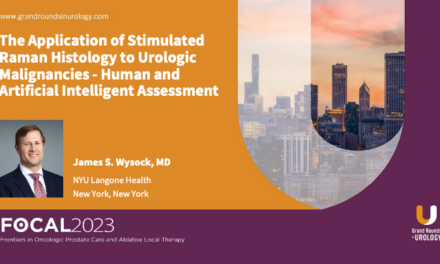
PCa Commentary | Volume 186 – February 2024
Posted by Edward Weber | February 2024
ACTIVE SURVEILLANCE: Patient Selection, Outcomes, and Monitoring for Gleason Grade Progression.
Question: Why not be treated at initial diagnosis of prostate cancer— and hope for cure?
Answer: Because all treatments are associated with unwelcome adverse effects that most men would prefer to avoid. Who should receive immediate treatment, and which men may safely delay treatment, preserving quality of life, — and with careful monitoring and timely intervention experience a similar outcome as if treated initially. That is the subject of this Commentary: patient selection for active surveillance (AS) and new techniques for monitoring for progression during AS.
Currently, eligibility for AS is based on clinical/pathological and biomarker features that define low- or favorable intermediate-risk prostate cancer: Gleason score 3+3 (Grade Group1) and Gleason score 3+4 (Grade Group 2); < 20% Gleason pattern 4; less than 50% positive biopsy cores and having only one NCCN intermediate risk factor (i.e., PSA 10-20 ng/ml, Gleason score 7 and cancer limited to the prostate). A PSA Density of <.15 and an MRI PIRAD score of 1 or 2 support AS.
Although Gleason Grade Group 1 is to a small extent heterogeneous, the behavioral heterogeneity of Gleason score 7 grouping has led to a sub-classification into “favorable (Gleason 3+4; Gleason Grade Group 2) and unfavorable intermediate-risk cancer (4+3; Gleason Grade Group 3), the latter not advised for AS. The concern regarding the extent of Gleason pattern 4 in Gleason score 3+4 is based on the understanding that prostate cancer cells with pattern 4 characteristics have the potential to invade and metastasize. Patients with <5% pattern 4, are deemed satisfactory for AS, whereas a rise toward 20% increases the advisability for early intervention.
The NCCN guidelines “prefer” AS as opposed to initial treatment for low-risk patients and allows consideration of AS for men with favorable intermediate-risk cancer with low PSA density (< .15) and low tumor volume ( i.e., < 2 positive cores), low genomic risk score and low percentage of Gleason pattern 4, i.e., <5%.
Brief Summary of Trail Outcomes of Active Surveillance in Patients with Gleason Grade Groups 1 and 2:
An extensive current review (Mukherjee et al., Journal Clinical Medicine, Dec. 2023) of outcomes for men with localized cancer (low-risk and favorable intermediate-risk) was based on a review of 712 studies from which 25 provided sufficient detail. Two representative studies will be briefly summarized:
- Courtney et al., (J.NCCN. 2022): Men on AS [8726 low-risk (LRPC) and 773 favorable intermediate-risk (FIRPC)] patients were followed for a median of 7.6 years. Metastasis-free survival at 10 years was 98.5% vs 90.4%; cancer-specific survival was 99% vs 96%, respectively.
- Mukhergee et al., (Eur. Urol. Open Sci., 2023): For men on AS (276 LRPC and 96 FIRPC) with median follow-up of 4.5 years. “… there was no significant difference in the median duration of AS between the two groups (32.5 months for IRPCvs 36 months for LRPC, p=0.53.” During the course of AS 30% had disease progression and were offered active treatment. The overall survival probability at 5 years for LRPC and FIRPC was 93% for both, and at 10-years 90% vs 83%s respectively.
Studies from John Hopkins and Toronto report 98-99% cancer-specific survival in carefully selected and monitored men with low- and favorable intermediate-risk cancer despite 36% to 50% conversion to treatment during AS due to Gleason grade progression (Data from NCCN 2022 guidelines). The excellent survival figures in all these studies point to the effectiveness of treatment in those men who progressed during AS.
The equivalence of outcome at intervention for carefully selected and monitored men on AS compared to those men treated with surgery at diagnosis has been multiply reported. Epstein, Carter et al., (Journal Urology, 2017) reported, ”Patients on active surveillance reclassified to grade group 2 or greater are at no greater risk for treatment failure than men newly diagnosed with similar grades.”
Genomic Classifiers (Decipher, Prolaris, OncotypeDx) provide greater prognostic accuracy than standard clinical/pathological classifications (cited above) for estimating progression in men with localized prostate cancer considering AS.
At the 2023 meeting the Society of Urologic Oncology Sheng et al. (Abst 237) reported that in a study of 235 men, Decipher Genomic Classifier (range of increasing concern for metastases and mortality extend from 0 -1.0) was associated with an upgrade to adverse pathology in men with a scores above 0.4 (p=.002) and above 0.6 (p=.006) – both values not suitable for men considering AS. A second study by Khandaker based on data from the Miami Active Surveillance Trial reported similar findings: Decipher scores >0.4 and increasingly above 0.6 were associated with adverse Gleason grade progression which would signal early intervention as opposed to AS.
The Next Step Forward: Predicting Future Progression Dynamically During AS as Opposed to Predictions Made Only at Baseline.
The clinical/pathological classification systems cited above offer prognostic (as opposed the predictive) information to guide patient selection but are not patient-specific. For example, a Decipher score of, say, 4.3 establishes a concerning level of risk but leaves the patient and physician a significant management decision about how to incorporate that extent of risk in a management plan. Studies using statistical analysis (see Cooperberg below) and Artificial Intelligence (see Lee and Nayan below) provide dynamic patient-specific predictions of adverse grade progression during the course of AS.
Cooperberg et al.,(JAMA Oncol, Aug 2020) addressed this issue in “Tailoring Intensity of Active Surveillance for Low-risk Cancer Based on Individualizing Prediction of Risk Stability.”
The Canary Prostate Active Surveillance Study (PASS) involves 9 academic medical centers and based their study on 850 very explicitly followed patients for at least 5 years following enrollment. Their product provided an individualized prediction at the time of diagnosis or during AS of ‘non-reclassification’ at 4 years – i.e., information that might guide continued participation in AS or a switch to intervention. “The Canary model was built to be calculable at any given landmark time or event in the course of active surveillance.” Their findings suggest that “based on an individual’s risk parameters, that many men may be safely monitored with a substantially less intensive surveillance regimen.”
Two other studies employed AI to predict grade progression during AS [Lee et al. (Nature Prostate Journal, Digital Medicine, Aug 2022) and Nayan et al. (Urol Oncol. Apr 2022)]. Both provided a guideline regarding future progression. Using AI and incorporating interval monitoring data (PSA, MRI and biopsies) each study estimated an ongoing “real life” prediction at any time during AS of the risk of future Gleason grade reclassification, information that could influence the decision to withdraw from AS and switch to active intervention.
BOTTOM LINE:
Active Surveillance is the preferred management option for men with low- and favorable intermediate-risk prostate cancer and has been shown to yield excellent outcomes. Genomic classifiers are further refining patient selection. Statistical analysis and artificial intelligence provide dynamic risk assessment for grade progression during the ongoing course of AS.
Please also visit https://prostatecancerfree.org/prostate-cancer-news for a selection of past issues of the PCa Commentary covering a variety of topics.
“We appreciate the unfailing assistance of the librarians at Providence/Swedish.”
ABOUT THE AUTHOR
Edward Weber, MD, is a retired medical oncologist living in Seattle, Washington. He was born and raised in a suburb of Reading, Pennsylvania. After graduating from Princeton University in 1956 with a BA in History, Dr. Weber attended medical school at the University of Pennsylvania. His internship training took place at the University of Vermont in Burlington.
A tour of service as a Naval Flight Surgeon positioned him on Whidbey Island, Washington, and this introduction to the Pacific Northwest ultimately proved irresistible. Following naval service, he received postgraduate training in internal medicine in Philadelphia at the Pennsylvania Hospital and then pursued a fellowship in hematology and oncology at the University of Washington.
His career in medical oncology was at the Tumor Institute of the Swedish Hospital in Seattle where his practice focused largely on the treatment of patients experiencing lung, breast, colon, and genitourinary cancer and malignant lymphoma.
Toward the end of his career, he developed a particular concentration on the treatment of prostate cancer. Since retirement in 2002, he has authored the PCa Commentary, published by the Prostate Cancer Treatment Research Foundation, an analysis of new developments in the prostate cancer field with essays discussing and evaluating treatment management options in this disease. He is a regular speaker at various prostate cancer support groups around Seattle.




